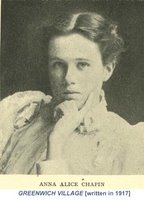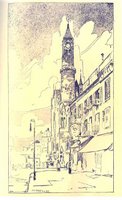"Commit the crime on 8th Street"
In 1917, a talented 37-year-old author was finishing her manuscript Greenwich Village. Recently widowed, Mrs. Robert Peyton Carter had relocated from West 112th Street (the northern precinct where her actor-husband had preferred to live) far downtown to 241 West 13th Street — — and she had fallen in love with her bohemian neighborhood.
 With several screenplays and even a Broadway play to her credit, the writer had no trouble attracting an illustrator to work on her project. Shortly after celebrating her 40th birthday, however, she sickened and died. OLD JEFF can picture this beauty in 1917, 90 years ago. Enjoy an excerpt from her book — — and her forever-young photograph. Anna Alice, gifted one, you live on in every New Yorker's history-loving heart!
With several screenplays and even a Broadway play to her credit, the writer had no trouble attracting an illustrator to work on her project. Shortly after celebrating her 40th birthday, however, she sickened and died. OLD JEFF can picture this beauty in 1917, 90 years ago. Enjoy an excerpt from her book — — and her forever-young photograph. Anna Alice, gifted one, you live on in every New Yorker's history-loving heart!• • • • Greenwich Village • • • •
By: Anna Alice Chapin [1880 — 1920]
Illustrator: Alan Gilbert Cram
[NY: DODD, MEAD & COMPANY, 1925; COPYRIGHT, 1917]
• • Illustration: JEFFERSON MARKET. The old clock that has told the hours of justice for Greenwich Village during many years.

— — excerpt — —
• • It is an odd coincidence that the present Jefferson Market Police Court stands now at Tenth Street — — though a good bit further inland than the ancient State’s Prison. The old Jefferson Market clock has looked down upon a deal of crime and trouble, but a fair share of goodness and comfort too. It is hopeful to think that the present regime of Justice is a kindlier and a cleaner one than that which prevailed when the treadmill and the dark cell were Virtue’s methods of persuading Vice. Someone, I know not who, wrote this apropos of prisons in Greenwich:
• • "In these days fair Greenwich Village
• • Slept by Hudson’s rural shores,
• • Then the stage from Greenwich Prison
• • Drove to Wall Street thrice a day — — —
• • Now the sombre ‘Black Maria’
• • Oftener drives the other way."
• • • • OLD JEFF: But I like to think that the old clock, if it could speak, would have some cheering tales to tell. I like to believe that ugly things are slipping farther and farther from Our Village, that honest romance and clean gaiety are rather the rule there than the exception, and that, perhaps, the day will sometime dawn when there will be no more need of the shame of prisons in Greenwich Village. ...
• • . . . the Village is a small place, and a true Village in its neighborliness and its readiness to pass a message along.
• • Really, there is nothing quainter about it than this intimate and casual quality, such as is known in genuine, small country towns. Fancy a part of New York City — — Gotham, the cold, the selfish, the unneighborly, the indifferent — — in which everyone knows everyone else and takes a personal interest in them too; where distances are slight and pleasant, where young men in loose shirts with rolled-up sleeves, or girls hat-less and in working smocks stroll across Sixth Avenue from one square to another with as little self-consciousness as though they were meandering down Main Street to a game of tennis or the village store! Sixth Avenue, indeed, has come to mean nothing more to them than a rustic bridge or a barbed-wire fence — — something to be gotten over speedily and forgotten. They even, by some alchemy of viewpoint, seem to give it a rural air from Jefferson Market down to Fourth Street — — these cool-looking, hat-less young people who make their leisurely way down Washington Place or along Fourth Street. People pass them — — people in hats, coats and carrying bundles; but the Villagers do not notice them. They do not even look at them pityingly; they do not look at them at all. Your true Green-Village denizen does not like to look at unattractive objects if he can possibly avoid it.
• • Of course, they do make use of Sixth Avenue occasionally, on their rare trips uptown. But it is in the same spirit that a country dweller would take the railway in order to get into the city on necessary business. As a matter of fact there is no corner of New York more conveniently situated for transportation than this particular section of Greenwich. I came across a picturesque real estate advertisement the other day:
• • • • “If you ever decide to kill your barber and fly the country, commit the crime at the corner of Eighth Street and Sixth Avenue. There is probably no other place in the world that offers as many avenues of flight.”
• • But nothing short of dire necessity ever takes a Villager uptown. He, or she, may go downtown but not up. Uptown nearly always means something distasteful and boring to the Village; they see to it that they have as few occasions for going there as possible. . . .
— — — — — — — —
• • Native New Yorker Anna Alice Hoppin, whose penname was Anna Alice Chapin [1880 — 26 February 1920], was an author who had received a private education and studied music under Harry Rowe Shelley. She wrote and published her first book A Story of Rhinegold [1897] when she was 17 years old. Other books were: Wonder Tales from Wagner (1898); Wotan, Siegfried, and Brunhilde (1898); Masters of Music (1901); Discords (1905); The Heart of Music (1906); Königskinder (1911); The Nowadays Fairy Book (1911); The Topsy Turvy Fairy (1913); The Eagle's Mate (1914); and Greenwich Village (1917), illustrated by Alan Gilbert Cram and published posthumously in 1925. Anna Alice Chapin also wrote several screenplays, short stories for magazines, and with Robert Peyton Carter, a British actor (16 years her senior) whom she married in 1906, a melodrama The Deserters, produced on Broadway in 1910. They had no children and Robert Peyton Carter predeceased her. After a short illness, 39-year-old Anna died at home: 241 West 13th Street. Her sister Mrs. Austen G. Fox, her literary executor, arranged for several manuscripts to be published and made into films during the 1920s.
__ ___
Source:http://jeffersonmarketcourthouseny.blogspot.com/atom.xml
Jefferson Market
• • Jefferson Market • Alan Gilbert Cram • 1917 •
NYC
New York Public Library
Jefferson Market.

Labels: 10011, 1917, Alan Gilbert Cram, Anna Alice Chapin, Greenwich Village, New York, NY, West 13th Street


<< Home